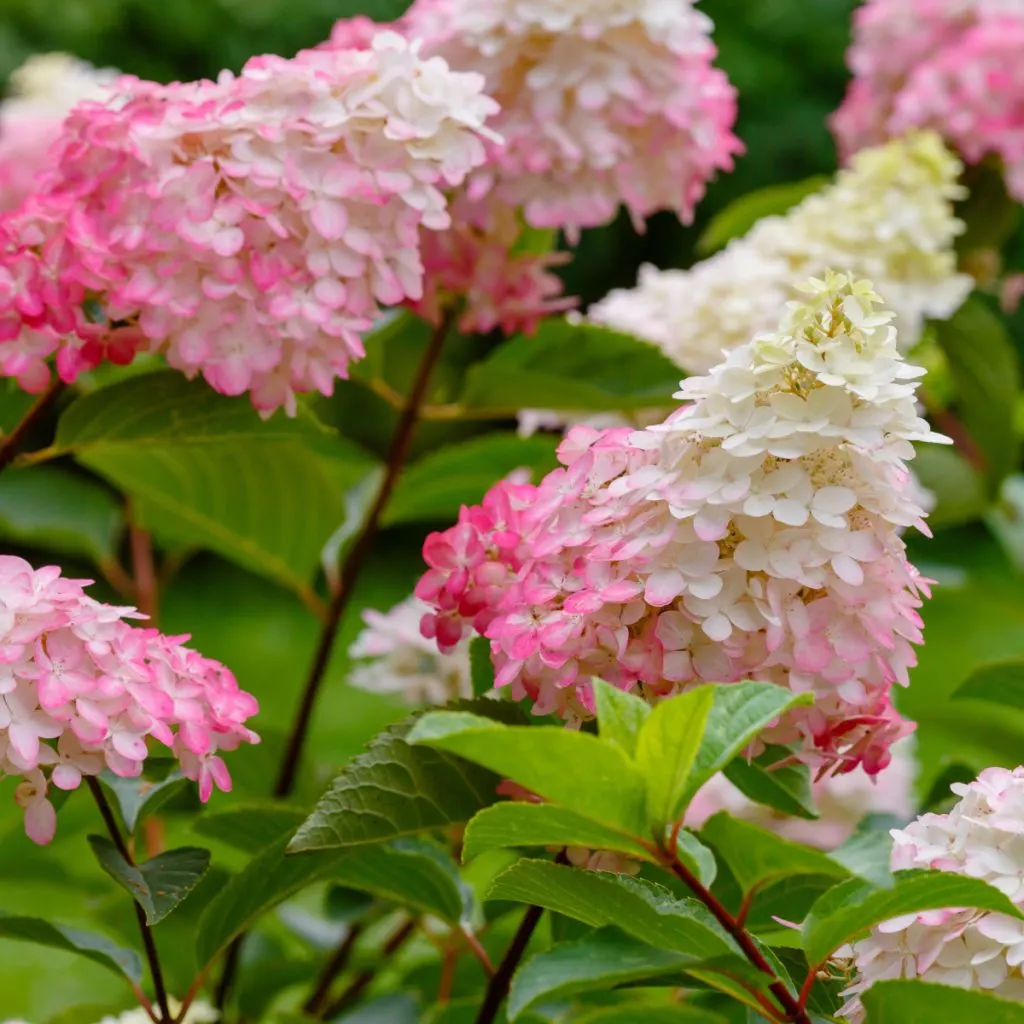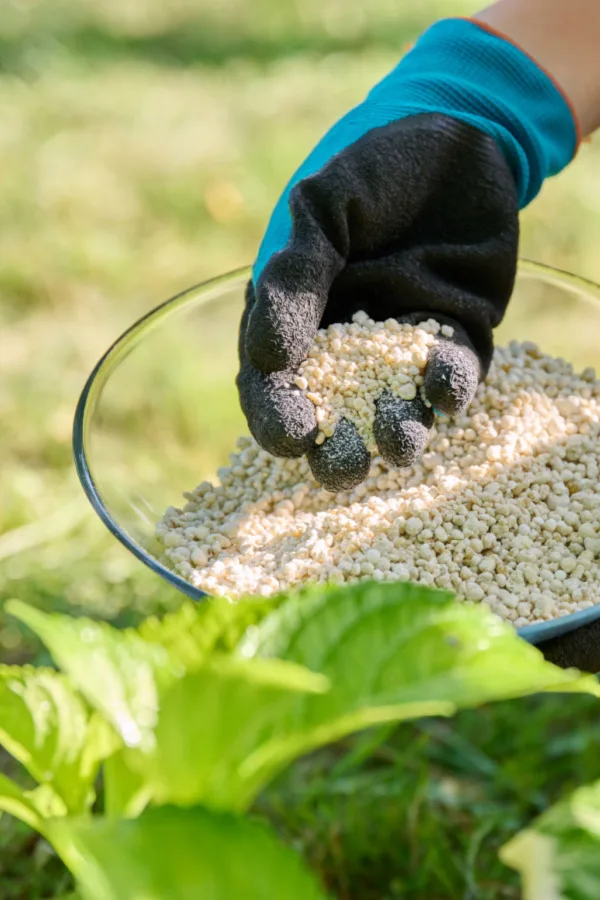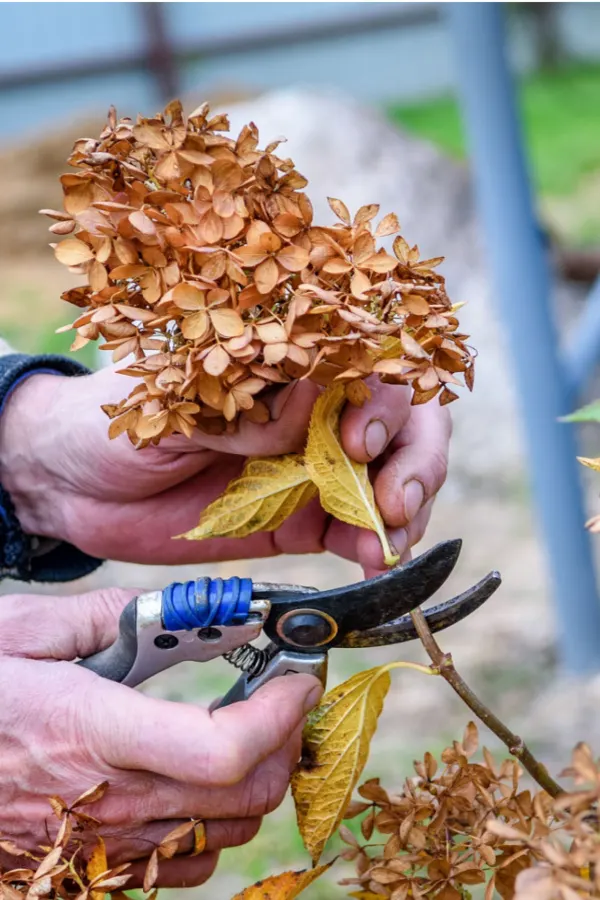Did you know that one of the most crucial times to care for your hydrangeas is in the fall – right before winter arrives? And that it can make a huge difference in just how well your bush performs and blooms next year – or whether it doesn’t at all!
One thing is for sure, what you do with your hydrangeas before winter arrives can make or break next year’s blooming performance. And unfortunately, all too often, gardeners make a few key miscues with their hydrangeas in the fall that unknowingly set their bushes up for failure the following season.
In many cases, as with fertilizing and pruning, those mistakes are actually due to too much care. But with that said, there are also a few key tasks such as deadheading and proper watering that need to occur in the autumn months to help your bushes stay healthy and strong through winter and into next season.

Today’s article will walk you through all of those – and help you avoid the four common mistakes made in the fall that can spell trouble for your hydrangeas next year!
4 Common Mistakes Gardeners Make With Hydrangeas In The Fall
#1 Fertilizing Hydrangeas In The Fall
Although providing your hydrangea with a little power late in the season may sound like a good idea – it is actually one of the worst times of all to fertilize. In fact, it can actually result in fewer or no blooms at all next year for your bush. Even worse, it can even put it at risk of freezing out over winter!
So why is fertilizing so bad for hydrangeas in the fall? For starters, hydrangeas are not a high-nutrient user. And when the soil around them is too rich in nutrients, it will cause them to use all of that energy simply to grow – all at the expense of future blooms.
But even more, feeding your hydrangeas in the fall will cause them to push out tender late season growth. And because that new wood is young and tender, it is highly susceptible to freezing out over winter.
It’s important to avoid all fertilizing in the fall with hydrangeas. Instead, wait until early spring right before or just as the bush is coming out to give it a dose of power. By fertilizing early in the season with the right fertilizer, your bush will use the nutrients to promote blooms – and not just growth! See our article: When & How To Fertilize In Early Spring For Big Blooms!

#2 Pruning Summer Blooming Hydrangeas In The Fall – 4 Common Mistakes Gardeners Make With Hydrangeas In The Fall
Plain and simple, if your hydrangea bush blooms in the summer – you should not prune it in the fall!
When it comes to types of hydrangeas, for the most part, they fall into two main categories – summer blooming and fall blooming. Summer blooming varieties include Oakleaf and Bigleaf, which happen to be two of the most popular to grace home landscapes.
Both Oakleaf and Bigleaf hydrangeas set their flowers early in the summer. But even though they finish blooming, they continue to grow out their stems and foliage. Why? Because it will contain the blooms that will flower the following season.
Unfortunately, when gardeners prune back summer blooming bushes in the fall, they remove all of next year’s blooms as well. So when is the best time to prune these hydrangeas? The answer is right after they finish blooming in the summer – and only then!
As for late summer and fall blooming hydrangeas, it’s best to wait until early spring to prune these varieties. Although these types form their blooms on new wood that grows in the same season, pruning in the spring allows the bush to handle winter better.
Listen In To Our Podcast Below!

#3 Not Removing Spent Blooms – 4 Common Mistakes Gardeners Make With Hydrangeas In The Fall
Although you shouldn’t prune your hydrangeas in the fall, you should cut back the old blooms before winter arrives. Allowing the blooms and old bloom stems to remain drains energy from the plant. In addition, it also puts it at risk of winter snow and ice damage.
Hydrangeas begin to store energy in their roots for the following season’s blooms in late summer and fall. Unfortunately, leaving the old blooms to die off and form seed heads takes a lot of power from the plant. Power that should be going to next year’s flowers!
By simply taking the time in the fall to cut these flower stems back and remove them – you can help power a bigger and better flower show next year.
#4 Watering Hydrangeas In The Fall – 4 Common Mistakes Gardeners Make With Hydrangeas In The Fall
All too often, gardeners make the mistake of not giving their hydrangeas water in the fall months. After all, the blooming is over so is it really important? The answer is yes!

Hydrangeas should be getting around one inch of rainfall or hand watering each and every week in the fall. The moisture not only helps the roots store up energy, it also helps the plant stay healthy and strong before winter’s arrival.
Hydrangeas that suffer from underwatering in the fall will not form as many blooms the following season. Nor will those blooms be as big and beautiful as they should be. So if nature isn’t providing the water – it’s important that you do!
Here is to avoiding the four most common mistakes with hydrangeas in the fall. And even more, to having your bushes full of big, bright, beautiful blooms next summer!
This Is My Garden
Follow Our Facebook Page For Great Gardening Tips And Advice! This Is My Garden Facebook Page
This Is My Garden is a garden website created by gardeners, for gardeners. Jim and Mary Competti have been writing gardening, DIY and recipe articles and books and speaking for over 15 years from their 46 acre Ohio farm. They publish three articles every week, 52 weeks a year. Sign up today to follow via email, or follow along!
